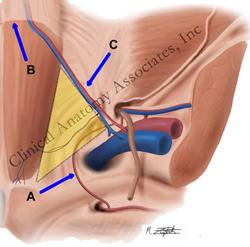UPDATED: The "triangle of doom" is a name given to a roughly triangular area in the posterior aspect of the anterior wall of the lower abdominopelvic region. It is used by surgeons repairing an inguinofemoral hernia with a mesh and they want to avoid large vascular structures, namely the external iliac artery and vein. The "triangle of doom" will be highlighted when you hover your cursor over the image.
The so-called "triangle of doom" is a misnomer perpetuated by the first laparoscopic surgeons who observed the anatomy of the inguinofemoral region from the posterior aspect. It is neither a triangle (as it only has two boundaries), nor is it an eponym (no such person existed - that is why uppercase should not be used). It does indicate an area where it is extremely dangerous to place staples or sutures during laparoscopic hernia surgery.
The "triangle of doom" is an inverted "V" shaped area with its apex at the internal (deep) inguinal ring. The "triangle of doom" is bound laterally by the gonadal vessels, and medially by the vas deferens in the male, or the round ligament of the uterus in the female. Within the boundaries of this area you can find the external iliac artery and vein.
It should be pointed out that although the "triangle of doom" landmark does protect the surgeon from damaging the external iliac vessels, a portion of these vessels lie outside of this area. In fact, there are several other areas of concern for neurovascular damage when performing a laparoscopic herniorrhaphy.
Hover over the image in this article, and the triangle of doom will appear. Clicking on the image will show a larger image of the posteroinferior abdominal region. The image also depicts other structures of anatomical importance for laparoscopic herniorrhaphy:
• Arcuate line (b)
• Hesselbach's triangle (in yellow)
• Aberrant obturator artery (Corona Mortis) (a)
• Inferior (deep) epigastric artery (c)
Image property of: CAA.Inc. . Artist: M. Zuptich.
Clinical anatomy of the inguinofemoral hernias, as well as abdominal and perineal hernias are some of the lecture topics developed and delivered to the medical devices industry by Clinical Anatomy Associates, Inc. For more information Contact Us.




